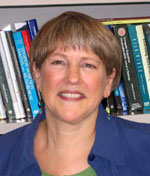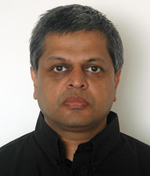Keynote Addresses
 |
The Web provides a platform for many forms of communities to share activities across time and space. In some cases the communities are emergent, taking advantage of whatever services and tools its members can find and use. In other cases the group members need support to discover one another, cohere and pursue shared goals. In this talk I will survey a number of design case studies conducted by my colleagues and I in the context of community system development, for groups that are both geographically bound and forming through computer-mediated interactions. The case studies are part of more than a decade of research and thus also offer an historical perspective on the emergence of many web-based services and technologies we now take for granted. I will use these case studies to reflect on what we have learned about contextual factors that must be understood and addressed in the course of building community information systems.
About Mary Beth Rosson
Mary Beth Rosson
is
Professor of Information Sciences and Technology at Pennsylvania State
University, where she co-directs the Computer-Supported Collaboration
and Learning Lab; she is also Affiliate Professor of Instructional Systems.
Prior to joining Penn State in 2003, she was Professor of Computer Science
at Virginia Tech and Research Staff Member IBM T. J. Watson Research
Center. Rosson is internationally known for her research and education
in human-computer interaction, including participatory and scenario-based
evaluation and design methods, computer-supported collaborative learning,
community informatics, and end user developmnt. She is author of Usability
Engineering: Scenario-Based Development of Human-Computer Interaction
(Morgan Kaufmann, 2002) and numerous articles, book chapters, and professional
tutorials. She has also served in many professional leadership roles,
including conference chair for OOPSLA 2000,
CHI 2007, and VL/HCC 2010. She is a member of the CHI Academy and an
ACM Distinguished Scientist. More details are available at http://mrosson.ist.psu.edu.
 |
I will talk about my experience in building a bank branch on a mobile phone, now operated by women 'branch managers' in thousands of far flung villages who cannot read or write English, and utilized by tens of lakhs of customers, many of them completely illiterate, to deposit, withdraw and transfer tiny sums of money, without direct intervention of anyone from outside the village. I will show live demonstration of how accounts are opened, cards issued, cash deposited, withdrawn and transferred using a very simple voice guided interface on a mobile phone.
About Mr. Anurag Gupta
Anurag Gupta, 49, graduated in architecture in 1982 from
SPA, Delhi. He started his professional career as a media company’s
creative lead for print and television campaigns. In 1985, he won a
national competition to design the extensions to the National Gallery
of Modern Art (Jaipur House). He set up an NGO called Information for
Action Teams (INFACT) in 1992, which worked for 2 years in Latur and
Osmanabad to create an extensive documentation of best practices to
retrofit non-engineered stone houses to strengthen them against a future
earthquake. Anurag worked with several Government agencies to disseminate
disaster vulnerability, low-cost building materials and simple construction
techniques, through documentaries, publications and exhibitions. Anurag
made three documentaries on street children and pavement dwellers of
Mumbai; and savings and credit systems developed by underprivileged
women in Ahmedabad and in Mumbai working with SEWA and SPARC. Several
of these were showcased on national television.
In 2000, Anurag set up A Little World, to attempt the creation of India’s
first payment system, focussed on small value transactions and the
bottom of pyramid segment. Anurag has mobilized industry opinion and
led initiatives with Banks, regulatory institutions, universities,
standards bodies, government and industry to support standardization
and enhanced security as the basis of mass deployment in the Indian
environment. In 2003, Anurag started a collaborative research and documentation
process with IIT-Bombay and the IDRBT-Hyderabad to pilot new generation
technologies for small value payment transactions. He started the Go-Mumbai
initiative for Automatic Fare Collection (AFC) in Mumbai buses and
local suburban railways in 2004 and built the mChek mobile payment
product in 2004. He has built the ZERO technology platform for branchless
banking, and brought key banks like SBI and industry majors such as
Nokia and NXP to support the implementation Financial Inclusion in
villages. In 2007 Anurag founded the Zero
Microfinance and Savings Support Foundation – a not-for-profit Section
25 Company which today acts as a Business Correspondent to 21 banks
in 18 States across India.
 |
Learning by doing is well known, a lot of people learn that way. But I wish to talk about learning by connecting creative people through multimedia, multi language, collaborative platform. Why has this vision for linking creative people in formal and informal sector remained undressed since 1997 when Sristi presented first such prototype made in tool kit at first Global Knowledge Conference? I attend meetings of several advisory committees on ICT applications at different level with in and outside the country but seem to hit a hard impermeable wall every time I mention this. May be the issue of accountability to mostly illiterate but thoughtful and creative people speaking in multitude of languages is not easy. May be this is not what funding agency consider as a mark of inclusiveness or social priority. May be it is messy and not very exciting technologically. There could be many other reasons.
What I propose to discuss are the priorities that I feel need to be addressed to use mobile phone based platform to share grassroots innovation database with Honey Bee Network, to help people learn from each other and also to craete bridge between formal and informal science.
I will also discuss how collaborative design platforms can be created to link designers beyond borders with grassroots innovators.
About Prof. Anil Gupta
Anil Gupta is a professor at Centre for Management in Agriculture, Indian
Institute of Management, Ahmedabad. One of his major endeavours has
been to support the grassroots level innovators who do not have a representation
in conferences, papers or communiqués. Their capacity to address their
own needs within their own context has not resulted in the three Rs
- Recognition, Respect and Reward - which Dr. Gupta has been striving
towards getting for the thousands of unknown creative people. He has
been able to take his mission forward by successfully expanding the
space – both global as well as local – for the grassroots innovators.
This achievement was possible due to sensitivity towards various issues
involved – whether it is a question of how to balance the best from
both formal and informal sciences; how to protect the individual intellectual
property rights and at the same time expand open source as a part of
‘technology commons’; the issues of ethics regarding conservation and
prospecting of biodiversity;
and, how to link innovations, investments and enterprise.
His vision has resulted in the creation of knowledge network at different
levels for augmenting grassroots green innovations and inventions in
informal and formal sector. In addition, he has been employing the learning
from grassroots innovations in helping organizations become more creative
and innovative from bottom up.
HoneyBee Network was established in 1988-89 to address the issues involved
with unsustainability of the methods of knowledge extraction from and
knowledge dissemination among the people. Later, in order to augment
HoneyBee Network, Dr. Gupta also established Society for Research and
Initiatives for Sustainable Technologies and Institutions (SRISTI, 1993,
www.sristi.org ), which aims to strengthen the creativity of grassroots
inventors, innovators and ecopreneurs engaged in conserving biodiversity
and developing eco-friendly solutions to local problems. Another endeavor,
Grassroots Innovation Augmentation Network (GIAN, 1997,www.gian.org),
helps scale up grassroots innovations and convert them into viable products
or services with appropriate benefit sharing arrangements.
Dr. Gupta was instrumental in setting up of National Innovation Foundation
(NIF, 2000, www.nifindia.org ) assisted by Department of Science and
Technology, Government of India to make India innovative and creative
society and a global leader in sustainable technologies.
 |
Can we move the debate on “Design-for” Development to being “Designed-with” Development? Can we envision a flexibility in ourselves to redesign ourselves as much as we design artefacts outside? Do we accept that transformation needs to happen to us and our methods as much as the community we seek to develop? Are our methods and beliefs as much up for grabs as the cherished values of the community that we are trying to transform with our technology?
I present a (South) African perspective where the challenge is to re-vision western methods to accord more closely with the multi-facetted local values. For Africans the challenge is how do we turn the insight, captured in the term ubuntu, that our humanity is intimately interconnected with, and dependent on, the community of the living and the dead, into something that helps us design computer artefacts? More formally: can we extract normative values for design from the implicitly held views of a community?
Further: is it not probable, once we accept the community as co-designers that we might not even have the last word in design? Can we accept that, as designers, we might never be able to remove uncertainty in purpose and functionality and thus we leave it up to the users to appropriate our artefacts for their own, unanticipated, uses? Uses that are literally and of necessity situated outside the perspectives which we are able to entertain?
About Prof. Edwin Blake
My awareness that Information and Communication Technology (ICT) needs
to be firmly based on community values arose from my involvement with
the South African National Information Technology Forum in the mid-nineties.
This organization’s finest contribution was the South African position
paper at the G7 conference on the Information Society and Development
that was held in 1996 in South Africa where the notion of an Information
Community was first formulated.
It rapidly became clear that I was not suited to the boring frustrations of governments and policy. I came to believe that knowledge that does not lead to effective action is not really knowledge and that failure of implementation is equivalent to a failure of understanding. By that definition most of the fine policies announced by government were failures.
A small project illustrating some concrete action was preferable. The
first such project (1996) was a system called CyberTracker that allowed
semi-literate animal trackers to reveal their deep understanding of
nature.
My research has focussed on the interaction of people and computers
applied so that it bridges the way ICT has to be applied in a Developing
Country.
Specifically my work covers flow, presence, storytelling and heritage
work in Virtual Environments and Computer Games, visualization and
ICT for Development (ICT4D). In the field of ICT4D my work has covered
tele-health
projects, location aware computing to support animal trackers and ICT
applications to assist deprived Deaf communities.
I am a South African with a Computer Science doctorate from Queen Mary College, London University, and I am currently Professor in Computer Science at the University of Cape Town.
